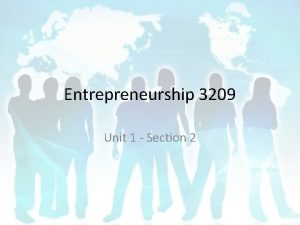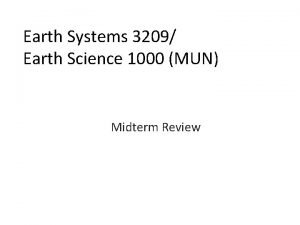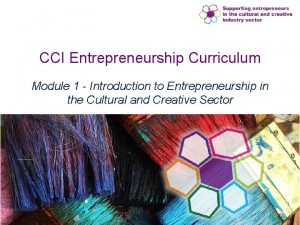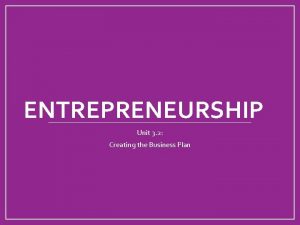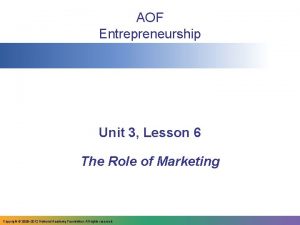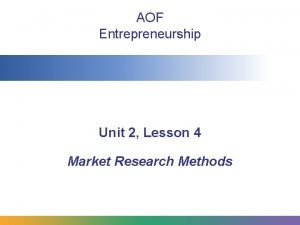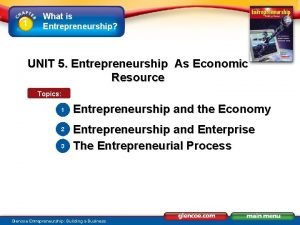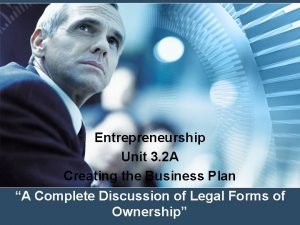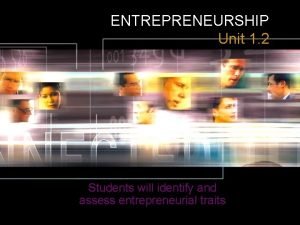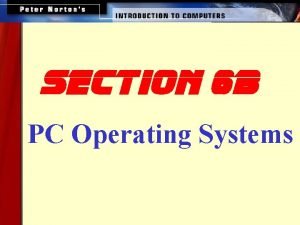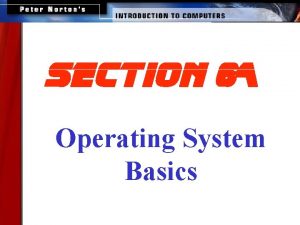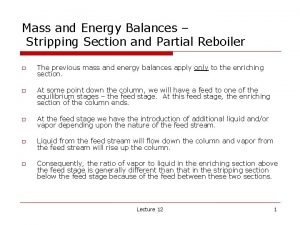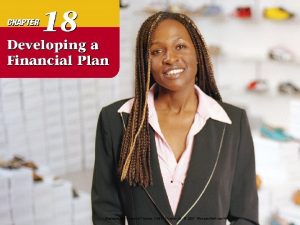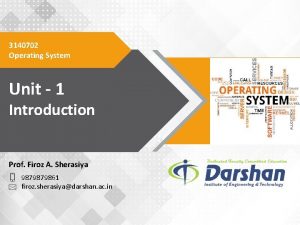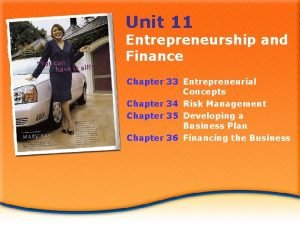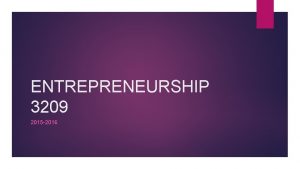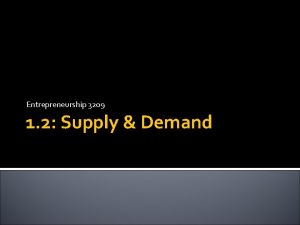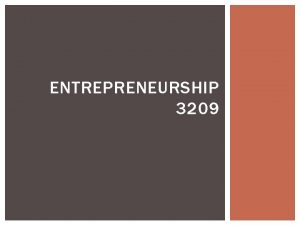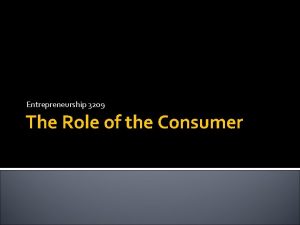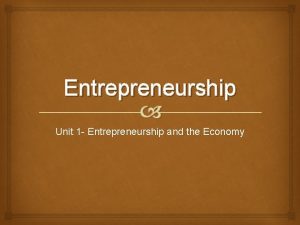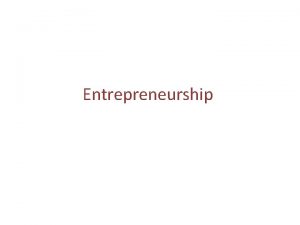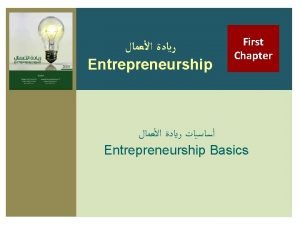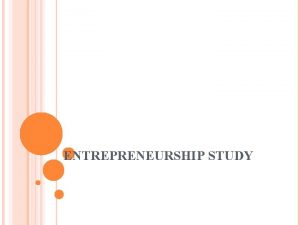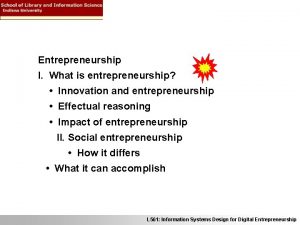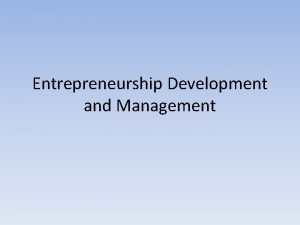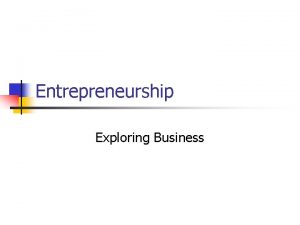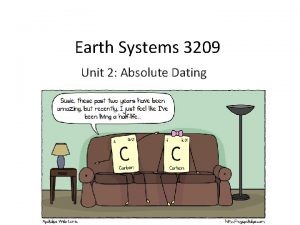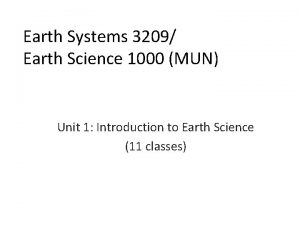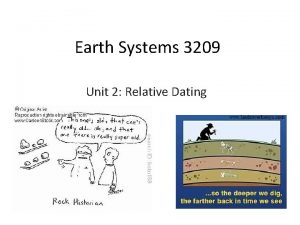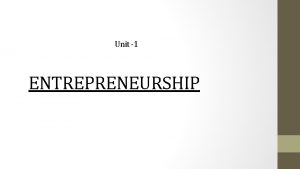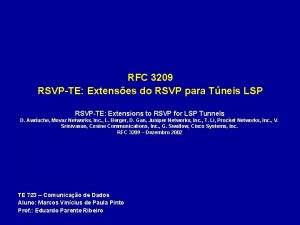Entrepreneurship 3209 Unit 1 Section 2 Operating a
























- Slides: 24

Entrepreneurship 3209 Unit 1 - Section 2

Operating a Business • Primary tasks in Running a Business –_ –_ –_ • Successful operation of a business requires attention to all of these areas of operation

Management and Human Resources • Planning, Organizing and controlling business operations • Wants to improve – _____: The resources used and the products or services that results. _______ resources used, ______ productivity – _____: The amount of time or effort put in to get a product or service. ______ effort/time, ____ efficency. – _________: Depends on need, qualifications, training etc. – _________: keeping good employees; depends on wages, perks, location, safety age etc.

Production • The factors of production – ________: The raw material that we get from the earth, water and air. Primary/extractive industries – ________: Ingredients that are transformed into another product – ____: All the physical or mental work needed to produce a good or service – _____: The money invested into a business – _____: to be competitive, a business must have this. About technology, competition, sources of supply etc. – _______: The people who control the factors of production.

Production cont… • Steps in producing goods or services –_ –_ –_ • _ • How can production be improved? –_

Financial Planning and Analysis • _____The process of recording, analyzing, and interpreting the financial or economic activities of a business. – _______: something that has value and is owned by someone (eg. ____) – ____: Debts or amounts that are owed to another – ___________: What you have left after all your debts are paid off • _ – ______: Net worth for a business • _

Financial Planning and Analysis • Reading/interpreting financial statements – ______: summarizes information about assets, liabilities, and owners equity. (Shows how a business is doing on a certain day. ) Pg. 282 • _____: the ease of converting an asset into cash (cash is the easiest converted, where a building much harder – it must be sold!)

Financial Planning and Analysis – _______: A second financial statement used to help a business report its profit or loss on business operations (shows how a business is doing over time) pg. 287 • Revenue (_________) • Expenses (________) • Net income (________) • _

• ________: The movement of cash in and out of a business • ___________: reports on a businesses cash flow over a period of time pg. 293

Marketing and Advertising • _______: is used to sell what a business makes and to manage a business’s brand(s) –_ • ________: the paid use of various types of media to try and convince consumers to buy a particular product or service

The 4 P’s and 2 C’s of marketing • _______: good product (or service) development look at: quality, design, features and benefits • _____: How high or low the price is can effect profit. How ________is the product? (how will sales change with a change in price) • _____: the path that a product goes in from producer to consumer (can be direct, indirect or specialty) • _______: Any attempt to sell a product – advertising, coupons, contests, premiums, samples and special events

The 4 P’s and 2 C’s of marketing cont… • ______: All sellers of a particular product. – _______: the percentage of the market that a company or brand has • _______: Characteristics of people who buy our products – ______________(research)

Advertising • Rules for good advertising: • 1: ______– headline that mentions the brand • 2: ______– simple, easy to read: clear to the point • 3. _______– help the customer want the product (a problem that your product can solve • 4: ______(to buy) – summarize the reasons to buy and where to get it (phone number, map) –*A reason to buy NOW!*

Legal Issues and Responsibilities • Regulations that govern business: • __________(___): Businesses show this through their values, ethics and contributions to the community. – Companies that ________community projects, keep employees safe and healthy etc. • _______: companies must disclose all important information to shareholders, business partners etc. – Employees must report if it comes to there attention that a law, regulation or policy has been violated.

Legal Issues and Responsibilities cont. • 6 major areas of laws for a business in Canada: –_ –_ –_ • Should a company have Ethical or moral obligations?

• Primary tasks in Running a Business –_ –_ –_ • Which three do you think are the most important? Why?

Businesses are Dynamic • Businesses are always changing as a result of the changing needs and wants of humans. –_ –_ –_

Product Life Cycle • All products have a limited life • Stages: –_ –_ –_

Business Life Cycle • Businesses often grow and then age • Stages: –_ –_ –_ • The Challenge: Businesses must _______to remain _____ in todays marketplace

Economic (Business) cycle • Economy-wide fluctuations (months to years) • Stages: – _______(expansion or boom) • Businesses increase production and sales – _______(recession) • Businesses have less output, profit and employees

A Successful Business • One that earns a profit while meeting a need in the marketplace • Factors: –_ –_ –_

Effective Leadership • Also a significant factor in running a successful business. • Desirable traits include: – calculated risk taking, – vision and passion, – perseverance, – teamwork.

Attracting and retaining customers • Successful businesses work diligently at this • Businesses pay _______to: – providing excellent _______, – determining _______and providing it, – producing _______.

ethical behavior and social responsibility • Consumer and public expectations in ________ and ________over the past several decades have ______ • A greater awareness about consumer choice –_ –_
 Scarcity entrepreneurship definition
Scarcity entrepreneurship definition Entrepreneurship 3209
Entrepreneurship 3209 Mun earth science
Mun earth science Introduction to entrepreneurship module pdf
Introduction to entrepreneurship module pdf Entrepreneurship unit 3
Entrepreneurship unit 3 Entrepreneurship unit 3
Entrepreneurship unit 3 Economics unit 3 lesson 6
Economics unit 3 lesson 6 Entrepreneurship unit 2
Entrepreneurship unit 2 Unit 5 entrepreneurship and business
Unit 5 entrepreneurship and business Unit 3 lesson 7 finance
Unit 3 lesson 7 finance Entrepreneurship unit 3
Entrepreneurship unit 3 Entrepreneurship unit 3
Entrepreneurship unit 3 Entrepreneurship unit 1
Entrepreneurship unit 1 Unit 6 review questions
Unit 6 review questions Section 6 operating systems
Section 6 operating systems Section 6 operating systems
Section 6 operating systems Stripping line equation
Stripping line equation Unit 5 operating your business lesson 1 funding sources
Unit 5 operating your business lesson 1 funding sources Difference between multiprogramming and multitasking
Difference between multiprogramming and multitasking Revolved section
Revolved section This view represents
This view represents Full sectional view
Full sectional view Describing energy section 2 answers
Describing energy section 2 answers Chapter 10 section 1 meiosis
Chapter 10 section 1 meiosis Disadvantages of entrepreneurship
Disadvantages of entrepreneurship

